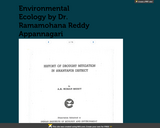
This article talks about climate change.
- Subject:
- Ecology
- Life Science
- Material Type:
- Case Study
- Author:
- Ramamohana Reddy Appannagari
- Date Added:
- 07/25/2017

This article talks about climate change.

This activity produces a fluent choral reading of Our Big Home: An Earth Poem, by Linda Glaser, when cooperative student groups rehearse, conduct vocabulary word study, and perform for their 4th grade peers.

The Network of Conservation Educators and Practitioners (NCEP) produces peer-reviewed teaching resources summarizing topics on conservation biology. Each module contains a synthesis document outlining the main concepts of a subject, a modifiable visual presentation, classroom exercises and solutions, teaching notes, and interdisciplinary case studies. For more information please visit where all NCEP modules are available free of charge.

The Network of Conservation Educators and Practitioners (NCEP) produces peer-reviewed teaching resources summarizing topics on conservation biology. Each module contains a synthesis document outlining the main concepts of a subject, a modifiable visual presentation, classroom exercises and solutions, teaching notes, and interdisciplinary case studies. For more information please visit where all NCEP modules are available free of charge.
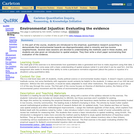
This assignment teaches students how to evaluate arguments concerning the maldistribution of environmental hazards, based on complex quantitative data.
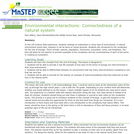
This is a field investigation of how a natural system is organized and the interconnectedness of an ecosystem.
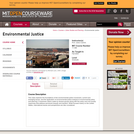
This class explores the foundations of the environmental justice movement, current and emerging issues, and the application of environmental justice analysis to environmental policy and planning. It examines claims made by diverse groups along with the policy and civil society responses that address perceived inequity and injustice. While focused mainly on the United States, international issues and perspectives are also considered.
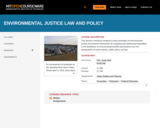
This seminar introduces students to basic principles of environmental justice and presents frameworks for analyzing and addressing inequalities in the distribution of environmental benefits and burdens from the perspectives of social science, public policy, and law.
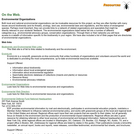
This online reference list provides links to nine local and national environmental organizations that have Web sites rich in valuable biodiversity information. Where possible, it includes the following information for each: details about the organization's mission, knowledge base, and activities; the type of support offered, including educational materials, resource libraries, and classes/workshops; and mailing address and contact information. In addition, links to four Web directories are provided, which in turn have links to dozens of other organizations.
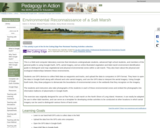
This is a field and computer laboratory exercise that introduces undergraduate students, advanced high school students, and members of the general public to using Google Earth, GPS, aerial imagery, and an online illustrated vegetation and tidal marsh environment identification guide to distinguish and map vegetational and physical environmental zones within a salt marsh. They also learn about the physical and ecological relationships between these environments.
Students use GPS devices to collect field data as waypoints and tracks, and upload the data to computers in GPX format. They learn to open the data in Google Earth along with infrared and color aerial imagery, and use the GPS data to interpret the aerial imagery. Using Google Earth tools, they draw polygons to demarcate the boundaries of environmental zones in the wetlands that they recognize on the imagery.
The students and instructors also take photographs of the students in each of these environmental zones and embed the photographs into information balloons of placemarks in Google Earth.
The exercise was originally designed for use at Flax Pond, a salt marsh on the North Shore of Long Island. However, it can easily be adapted for use in other tidal marshes, and can serve as a template for developing similar activities to be conducted at other locations in which aerial imagery can be used to distinguish various forms of land cover.
(Note: this resource was added to OER Commons as part of a batch upload of over 2,200 records. If you notice an issue with the quality of the metadata, please let us know by using the 'report' button and we will flag it for consideration.)
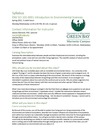
In this syllabus from Spring 2022, Dr. Jessica Warwick provides bibliographic citations for open education resources used in place of a traditional textbook. Topics include: Environmental Challenges; Ecosystem Cycling; Species Interactions; Populations; Evolution; Niches; Biomes; Biodiversity; Threats to Species; The Human Population; Food Issues; Agriculture; Sustainable Agriculture; Water; Soils; Non-Renewable Energy; Climate Change; Renewables; Economics; Politics
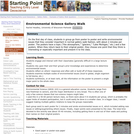
Gallery walk activity that relies on students' prior knowledge of environmental issues as an introductory activity in a general education, large-lecture format environmental science class.
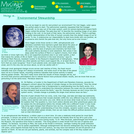
This online article, from the museum's Musings newsletter for educators, provides an introduction to environmental stewardship. It discusses Earth's rarity as a planet that supports life and the mounting evidence that indicates human activity is, indeed, altering global climate.
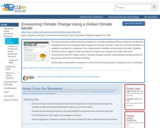
This long classroom activity introduces students to a climate modeling software. Students visualize how temperature and snow coverage might change over the next 100 years. They run a 'climate simulation' to establish a baseline for comparison, do a 'experimental' simulation and compare the results. Students will then choose a region of their own interest to explore and compare the results with those documented in the IPCC impact reports. Students will gain a greater understanding and appreciation of the process and power of climate modeling.
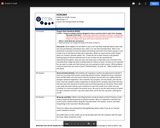
In this lesson, students will learn what erosion is and how human actions influence erosion. Includes introduction, demonstration instructions, and questions for wrap-up discussion.
NGSS: 2-ESS2-1
Time: 50 minutes
Materials: plastic containers with sand and gravel, sponges, and plastic cups
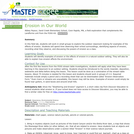
This activity is a field investigation where students find real-life examples of erosion in their school surroundings. Students will extend what they learned during stream table lessons about erosion, deposition, deltas, meandering streams, and dams.

This article aligns the concepts of Essential Principle 2 of the Climate Sciences to the K-5 content standards of the National Science Education Standards. The author also identifies common misconceptions about heat and the greenhouse gases effect and offers resources for assessing students' understanding of interactions among components of the Earth system. This article continues the examination of the climate sciences and climate literacy on which the online magazine Beyond Weather and the Water Cycle is structured.
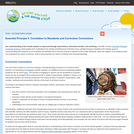
Each issue of the free, online magazine Beyond Weather and the Water Cycle explores an essential principle of climate science and climate literacy with background information, lessons, activities, original stories, and more for the K-5 classroom. This article shows the alignment of these materials with the content standards of the National Science Education Standards.
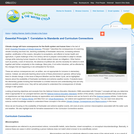
This article identifies age-appropriate national science education content standards and curriculum connections for introducing complex concepts contained in Principle 7 of the Essential Principles of Climate Sciences. The principle describes consequences of climate changes on Earth systems and human lives. The content standards will help teachers determine appropriate topics for their students. A number of resources from the online magazine Beyond Weather and the Water Cycle are highlighted for their connection to the science curriculum in the early grades. In addition, the article identifies common misconceptions about weather and the water cycle often held by students.
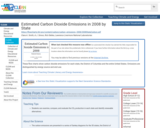
These flow charts show carbon dioxide emissions for each state, the District of Columbia and the entire United States. Emissions are distinguished by energy source and end use.